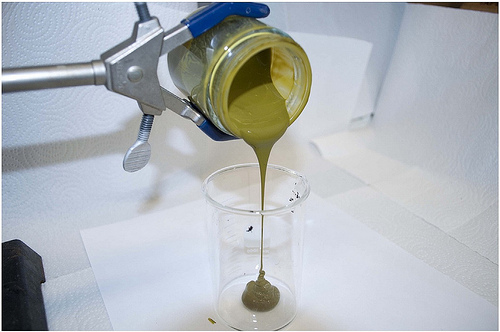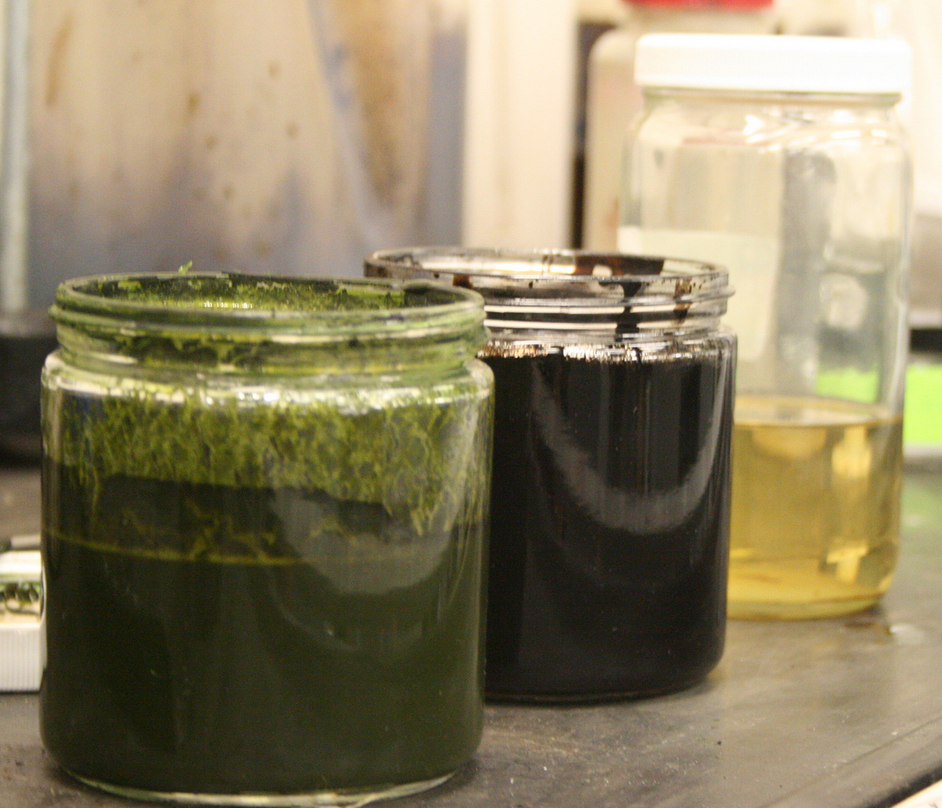Converting algae to crude oil — a million-year natural process — in minutes
December 20, 2013

Algae slurry (credit: PNNL)
Utah-based Genifuel Corp. has licensed the technology and is working with an industrial partner to build a pilot plant using the technology.
How to create ‘instant oil’
[+]
A slurry of wet algae is pumped into the front end of a chemical
reactor. Once the system is up and running, out comes crude oil in less
than an hour. With additional conventional refining, the crude algae oil
is converted into aviation fuel, gasoline, or diesel fuel.
(L-R):
Algae slurry, biocrude oil, and (with further processing) refined
biocrude, which contains mostly the makings of gasoline and diesel fuel
(credit: PNNL)
The process also creates waste water — which is processed further, yielding burnable gas — and substances like potassium and nitrogen, which, along with the cleansed water, can also be recycled to grow more algae.
[+]
While algae has long been considered a potential source of biofuel,
and several companies have produced algae-based fuels on a research
scale, the fuel has been projected to be expensive. The PNNL technology
harnesses algae’s energy potential efficiently and incorporates a number
of methods to reduce the cost of producing algae fuel.
Process scheme utilizing algae growth and hydrothermal processing for fuel (credit: PNNL)
Eliminating slow, energy-inefficient drying and hexane steps
PNNL scientists and engineers simplified the production of crude oil from algae by combining several chemical steps into one continuous process. The most important cost-saving step is that the process works with wet algae. Most current processes require the algae to be dried — a process that takes a lot of energy and is expensive. The new process works with an algae slurry that contains as much as 80 to 90 percent water.
While a few other groups have tested similar processes to create biofuel from wet algae, most of that work is done one batch at a time. The PNNL system runs continuously, processing about 1.5 liters of algae slurry in the research reactor per hour. While that doesn’t seem like much, it’s much closer to the type of continuous system required for large-scale commercial production.
The PNNL system also eliminates another step required in today’s most common algae-processing method: the need for complex processing with solvents like hexane to extract the energy-rich oils from the rest of the algae. Instead, the PNNL team works with the whole algae, subjecting it to very hot water under high pressure to tear apart the substance, converting most of the biomass into liquid and gas fuels.
Pressure cooker
The system runs at around 350 degrees Celsius (662 degrees Fahrenheit) at a pressure of around 3,000 PSI, combining processes known as hydrothermal liquefaction and catalytic hydrothermal gasification. Elliott says such a high-pressure system is not easy or cheap to build, which is one drawback to the technology, though the cost savings on the back end more than makes up for the investment.
“It’s a bit like using a pressure cooker, only the pressures and temperatures we use are much higher,” said Douglas Elliott, the laboratory fellow who led the PNNL team’s research. “In a sense, we are duplicating the process in the Earth that converted algae into oil over the course of millions of years. We’re just doing it much, much faster.”
The recent work is part of DOE’s National Alliance for Advanced Biofuels & Bioproducts (NAABB), funded with American Recovery and Reinvestment Act funds by DOE’s Office of Energy Efficiency and Renewable Energy. Both PNNL and Genifuel have been partners in the NAABB program.
Abstract of Algal Research paper
Wet algae slurries can be converted into an upgradeable biocrude by hydrothermal liquefaction (HTL). High levels of carbon conversion to gravity separable biocrude product were accomplished at relatively low temperature (350 °C) in a continuous-flow, pressurized (sub-critical liquid water) environment (20 MPa). As opposed to earlier work in batch reactors reported by others, direct oil recovery was achieved without the use of a solvent and biomass trace components were removed by processing steps so that they did not cause process difficulties. High conversions were obtained even with high slurry concentrations of up to 35 wt.% of dry solids. Catalytic hydrotreating was effectively applied for hydrodeoxygenation, hydrodenitrogenation, and hydrodesulfurization of the biocrude to form liquid hydrocarbon fuel. Catalytic hydrothermal gasification was effectively applied for HTL byproduct water cleanup and fuel gas production from water soluble organics, allowing the water to be considered for recycle of nutrients to the algae growth ponds. As a result, high conversion of algae to liquid hydrocarbon and gas products was found with low levels of organic contamination in the byproduct water. All three process steps were accomplished in bench-scale, continuous-flow reactor systems such that design data for process scale-up was generated.
(¯`*• Global Source and/or more resources at http://goo.gl/zvSV7 │ www.Future-Observatory.blogspot.com and on LinkeIn Group's "Becoming Aware of the Futures" at http://goo.gl/8qKBbK │ @SciCzar │ Point of Contact: www.linkedin.com/in/AndresAgostini
 Washington
Washington